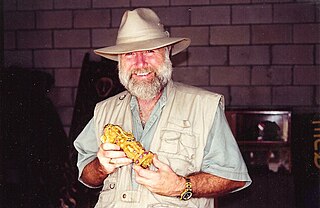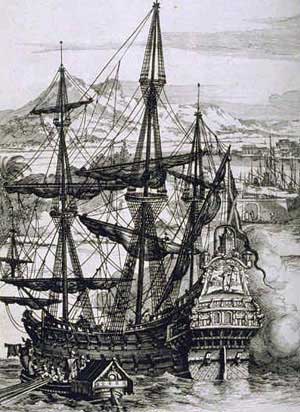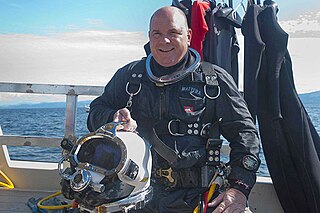
Robert Forrest Burgess (born November 30, 1927) is an American author of non-fiction adventure books, as well as sport fishing and scuba diving magazine articles. His photographs illustrate his material.

Robert Forrest Burgess (born November 30, 1927) is an American author of non-fiction adventure books, as well as sport fishing and scuba diving magazine articles. His photographs illustrate his material.
Robert F. Burgess was born in Grand Rapids, Michigan, on November 30, 1927. He built his first diving gear out of a World War II gas mask, 50 feet of air hose, and an air compressor to explore a Michigan shipwreck in 1944. At the end of World War II, he served as a ski trooper with the 88th Infantry Division named the Blue Devils by the Germans, and took his GI Bill abroad, studying French first at the Berlitz Language School in Trieste, Italy, and later at the University of Neuchâtel in Switzerland.
During this time he skied the Alps as part of the University's athletic program. Returning to Trieste to sell his German Amphibious Jeep, he and a companion purchased an Italian Lambretta motor scooter and rode it back to Switzerland, crossing the Great St. Gothard Pass and two other major mountain ranges at night. For their summer vacation he and a companion moved to Italy's Island of Capri for three months where they learned to skin dive.
After studying abroad he returned to the U.S. to complete his education, majoring in Journalism at Michigan State University. Then, moving to Florida he wrote and photographed features for every major U.S. outdoor magazine including several abroad.
With his new bride, Burgess returned to Switzerland in 1956. In Milan they purchased an Italian Lambretta motor scooter that winter, riding it 700 miles, across the Rivieras to Spain, where they took a ferry to the Balearic Islands. They wintered on the island of Majorca, where he fished with Majorcan trawler fishermen, gathering material for a novel. That spring they ferried to Valencia and motor scootered across Spain to Madrid, where he and his wife lived for the next 31⁄2 years. While there Burgess wrote his first novel and numerous travel articles for periodicals in England, Spain and America.
During that time, on assignment for "Argosy" Magazine, he and a companion crossed the Mediterranean aboard a freighter with the French Foreign Legion, then back-packed through Tunisia to find and climb Hill 609, a fortified German mountain fortress during World War II.
Returning later to the U.S., he served as editor for the "Florida Outdoors Magazine" wrote free-lance features for sport diving and sport fishing magazines throughout the country, and for the last 20 years has contributed articles on these subjects as Editor-At-Large for the "Florida Sportsman Magazine".
Over the years Burgess has written and published over twenty books on such subjects as sharks, shipwrecks, underwater archaeology, treasure diving, cave diving, travel, and Ernest Hemingway (whom he met in Pamplona during that author's last Pamplona fiesta).
In January 1994, Scuba Schools International awarded Robert Burgess their most prestigious award, given only to divers with verified log books who have met or exceeded all their requirements, including at least 5,000 dives, to achieve the elite SSI rating of Platinum Pro 5000 Diver.
Robert F. Burgess lives in north Florida, where he continues to write magazine articles and books.

Wreck diving is recreational diving where the wreckage of ships, aircraft and other artificial structures are explored. The term is used mainly by recreational and technical divers. Professional divers, when diving on a shipwreck, generally refer to the specific task, such as salvage work, accident investigation or archaeological survey. Although most wreck dive sites are at shipwrecks, there is an increasing trend to scuttle retired ships to create artificial reef sites. Diving to crashed aircraft can also be considered wreck diving. The recreation of wreck diving makes no distinction as to how the vessel ended up on the bottom.
Mel Fisher was an American treasure hunter best known for finding the 1622 wreck of the Nuestra Señora de Atocha in Florida waters.
Sheck Exley was an American cave diver. He is widely regarded as one of the pioneers of cave diving, and he wrote two major books on the subject: Basic Cave Diving: A Blueprint for Survival and Caverns Measureless to Man. On February 6, 1974, Exley became the first chairman of the Cave Diving Section of the American National Speleological Society. During his career, he established many of the basic safety procedures used in cave and overhead diving today. Exley was also a pioneer of extreme deep scuba diving.

Nuestra Señora de Atocha was a Spanish treasure galleon and the most widely known vessel of a fleet of ships that sank in a hurricane off the Florida Keys in 1622. At the time of her sinking, Nuestra Señora de Atocha was heavily laden with copper, silver, gold, tobacco, gems, and indigo from Spanish ports at Cartagena and Porto Bello in New Granada and Havana, bound for Spain. The Nuestra Señora de Atocha was named for the Basilica of Nuestra Señora de Atocha in Madrid, Spain. It was a heavily armed Spanish galleon that served as the almirante for the Spanish fleet. It would trail behind the other ships in the flotilla to prevent an attack from the rear.

San Pedro Underwater Archaeological Preserve State Park is a Florida State Park located in 18 feet (5.5 m) of water, approximately 1.25 nautical miles (2.32 km) south of Indian Key. It became the second Florida Underwater Archaeological Preserve when it opened to the public in 1989. The heart of the park is the San Pedro, a submerged shipwreck from a 1733 Spanish flotilla, around which visitors can dive and snorkel. The San Pedro, a 287-ton Dutch-built vessel, and 21 other Spanish ships under the command of Rodrigo de Torres left Havana, Cuba, on Friday, July 13, 1733, bound for Spain. The San Pedro carried a cargo of 16,000 silver Mexican pesos and crates of Chinese porcelain. A hurricane struck the fleet, while entering the Straits of Florida, and sank or swamped most of the fleet. The wrecksite includes an "eighteenth century anchor, replica cannons, ballast stones encrusted with coral, a dedication plaque, and a mooring buoy system." The wreck was added to the U.S. National Register of Historic Places on May 31, 2001.

Treasure hunting is the physical search for treasure. For example, treasure salvors try to find sunken shipwrecks and retrieve artifacts with archaeological value. In many instances, it takes treasure salvors months or years of searching before they even find the lost ship(s) for which they are searching. It is a very expensive process which is why archaeologists rely on treasure salvors for the information recovered. In many instances, discovery of a wreck only occurs after searching tens of thousands of nautical miles and recovery would be impossible for archaeologists due to the depth of the wreck. In Florida, treasure salvors generously donate 20% of material found on each site to the state for display in museums while also meticulously cataloguing each artifact for archaeologists and contributing much knowledge to the understanding of the wreck itself.

Edward Lee Spence is a German-born American archaeologist. He is a specialist in the field of underwater archaeology.
John Christopher Fine of Scarsdale, New York is a marine biologist with a doctor of jurisprudence degree and has dived on shipwrecks all over the world. He is a Master Scuba Instructor and Instructor Trainer, and the author of over two dozen books on almost as many topics, including award-winning books dealing with ocean pollution. He has authored both fiction and non-fiction books.

Robert F. Marx was an American pioneer in scuba diving, a prolific author, and was best known for his work as an avocational marine archaeologist. Over his career, he discovered over 5000 shipwrecks in over 60 countries. Although some accused him of treasure hunting, fellow avocational archeologist E. Lee Spence described Marx as the "true father of underwater archaeology". Marx also helped write UNESCO legislation regarding shipwrecks.

George Robert Fischer was an American underwater archaeologist, considered the founding father of the field in the National Park Service. A native Californian, he did undergraduate and graduate work at Stanford University, and began his career with the National Park Service in 1959, which included assignments in six parks, the Washington, D.C. Office, and the Southeast Archaeological Center from which he retired in 1988. He began teaching courses in underwater archaeology at Florida State University in 1974 and co-instructed inter-disciplinary courses in scientific diving techniques. After retirement from the NPS his FSU activities were expanded and his assistance helped shape the university's program in underwater archaeology.
Gary Gentile is an American author and pioneering technical diver.

Tom Mount was an American pioneering cave diver and technical diver.
"Captain" Billy Deans is a pioneering wreck and technical diver. "Captain" is the nickname which is widely applied to Billy Deans, however he is a US Coast Guard-rated captain up to 100 tons.

Robert Pierre André Sténuit was a Belgian journalist, writer, and underwater archeologist. In 1962, he spent 24 hours on the floor of the Mediterranean Sea in the submersible "Link Cylinder" developed by Edwin Link, thus becoming the world's first aquanaut.
Lt. Col. William Robert Royal was an American scuba diver in the United States Air Force and amateur archeologist. In 1959, Royal and Eugenie Clark found archaeologically, pale-ontologically, and geologically significant artifacts and human bones from at least 30 individuals in Little Salt Spring and Warm Mineral Springs. A partially burned log found in association with some of the human bones was radiocarbon dated to about 10,000 years ago. If the bones were the same age as the log, then the bones were the oldest known evidence of human occupation in Florida at the time.

John Joseph Mattera is a writer and American shipwreck explorer and the subject of the book Pirate Hunters by Robert Kurson. Pirate Hunters is the story of two US divers, John Chatterton and John Mattera, finding the lost pirate ship Golden Fleece of Captain Joseph Bannister in the waters off the Dominican Republic in 2008. Mattera first became a certified diver in 1976, exploring the North Atlantic, he was an early pioneer of the shipwrecks in the waters around New York and New Jersey, performing penetration and decompression dives long before technical diving had a name. From the late 1970s on exploring some of the most famous shipwrecks of the northeast, with over sixty dives on the SS Andrea Doria.

The following index is provided as an overview of and topical guide to underwater divers:

This is a list of underwater divers whose exploits have made them notable. Underwater divers are people who take part in underwater diving activities – Underwater diving is practiced as part of an occupation, or for recreation, where the practitioner submerges below the surface of the water or other liquid for a period which may range between seconds to order of a day at a time, either exposed to the ambient pressure or isolated by a pressure resistant suit, to interact with the underwater environment for pleasure, competitive sport, or as a means to reach a work site for profit or in the pursuit of knowledge, and may use no equipment at all, or a wide range of equipment which may include breathing apparatus, environmental protective clothing, aids to vision, communication, propulsion, maneuverability, buoyancy and safety equipment, and tools for the task at hand.
Valerie Olson van Heest is an American author, explorer, and museum exhibit designer. She is co-founder of the Michigan Shipwreck Research Association.